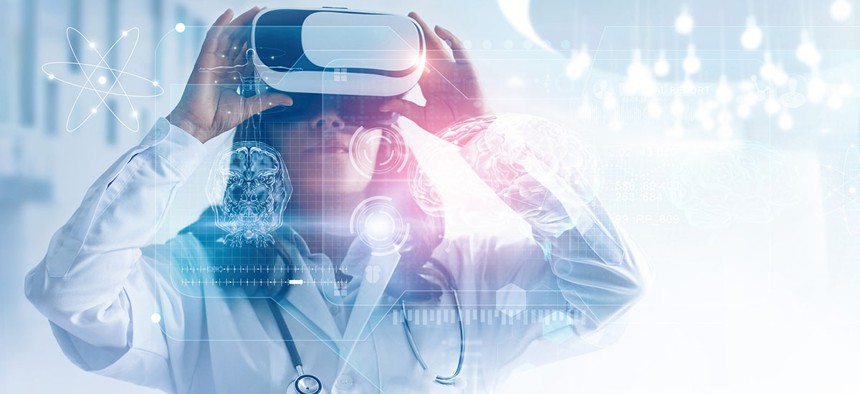sponsor content What's this?

iStock/ipopba
Immersive Medical and Emergency Training Powered by 5G Saves Time, Resources
Presented by
Verizon

Rigorous training programs are essential to delivering fast and effective health care and emergency response, but traditional in-person simulations require significant investments in staff, equipment and travel. Immersive virtual training powered by 5G could revolutionize how medical and public safety personnel prepare for critical situations in the operating room and out in the field.
Immersive virtual technologies encompass both virtual reality and augmented reality. Via virtual reality, or VR, the user is entirely immersed in a virtual setting — for example, in a simulated emergency scenario. Augmented reality, or AR, overlays virtual elements in the user's real-life environment. This could include overlaying an image on the operating table to aid during surgery.
Tailored Training for Health Care Professionals
"When you choose a physician, you may want somebody who's done thousands of surgeries. But someone has to be the first patient," says Tony Dolezal, a 5G and Multi-Access Edge Computing, or MEC, specialist with the Public Sector Field Marketing group at Verizon Wireless. Through immersive training, a physician can virtually experience a procedure dozens of times before actually operating on that first patient.
A career in the medical field requires continuous learning. Health care delivery is constantly changing and health care workers must evolve alongside it. Even the most seasoned physician needs extensive practice using new techniques or devices before moving to direct patient care.
Traditionally, a medical device company might host a days long training at its own facilities, tying up busy health care workers. Using VR and AR, medical professionals can learn at their home facilities and continue to practice beyond the initial training sessions.
Surgeons can also use 5G-enabled VR/AR technology to create 3D versions of a patient's unique anatomy and run through a procedure numerous times before even entering the operating room.
"They're leveraging the bandwidth and low latency of 5G, and more efficient computing, to enable fully interactive virtual reality and augmented reality," Dolezal says. That low latency creates a smooth experience for users, resulting in high-quality training requiring fewer resources.
Approximately 100,000 deaths occur annually because of medical errors. By enabling physicians to engage in more frequent and highly tailored practice sessions, AR/VR immersive training could save lives.
Using VR/AR Technology to Prepare for Disaster
Outside of hospitals and operating rooms, more training enables better outcomes in the field. Previously, immersive emergency response training required hiring actors to play victims, a costly and complicated endeavor.
"When you're looking at AR/VR training enabled by 5G, you have the ability to create a better-trained force at less expense," Dolezal says. "And of course, less expense in training means those resources can be used for additional officers or additional fire trucks."
Basic training alone requires an average of 833 hours, according to state and local law enforcement academies. On top of that, officers and first responders have ongoing training needs throughout their careers. Traveling for in-person sessions means even more time away from the field.
"I can remember back when I was on the police force that if we had people who needed to go for retraining or certification, it really put a strain on us in the field," says Jason Mitchell, a senior manager with the Verizon Frontline Crisis Response team. "We were required to not only work longer hours, but we were also down on headcount, so we had a potential safety issue there as well."
AR/VR immersive training offers myriad benefits, but the biggest challenge is the enormous amount of bandwidth and computing power it requires. MEC and 5G connectivity are critical to creating a superior experience. The combination of 5G and MEC allows for complex image processing without noticeable lags, making the training as close to true reality as possible.
"Being able to produce any training experience anywhere at a fraction of the cost results in more trained personnel," Dolezal says. "Not only in the number of personnel trained, but also in how well they're trained."
Sponsored Content from Verizon: This content is made possible by our sponsor, Verizon. The editorial staff was not involved in its preparation.
NEXT STORY: How 5G Enhances Situational Awareness and Optimizes Public Safety Response






